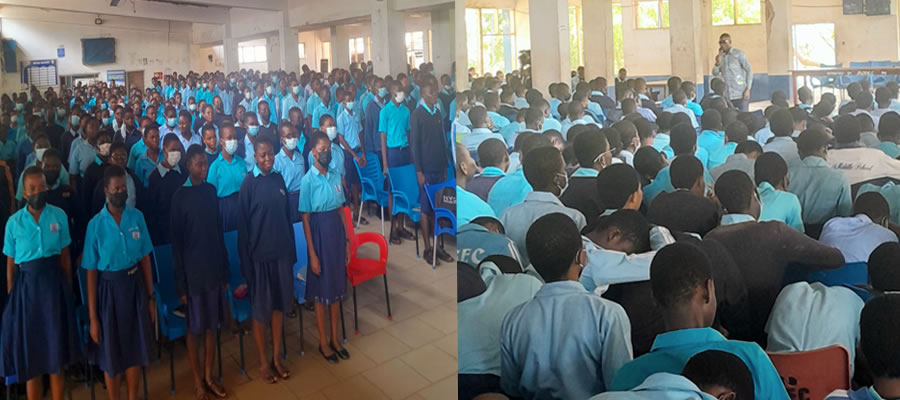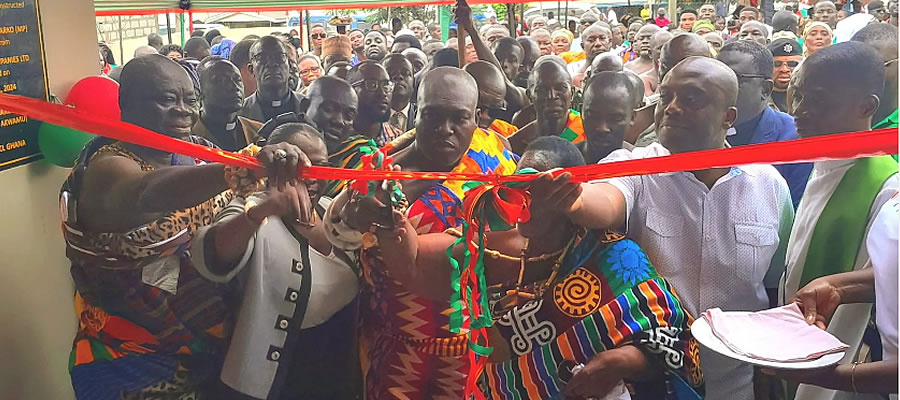

By West African standards, Ghana has a diverse and rich resource base. The country depends mainly on agriculture and majority of its people are engaged in farming. Cocoa which is the main cash crop provide about two-thirds of export revenue as well as other cash crops like timber products, palm products, shea nuts (which produce an dibble fat), and coffee.
Ghana has also established a successful program of non-traditional agricultural products for export including pineapples, black pepper cashews, banana and pepper. Cassava, yam, plantain, corn, rice, peanut, millet, and sorghum are the basic food stuffs. Fish, poultry, and meat are also important dietary staples. The goals are defined for the following broad sectors;
Economic Development
To diversify the local economy and increase agricultural production.
Access to Information Technology and communication.
Access to credit facilities
Private sector participation in development
Income, Expenditure
Income
The main sources of income are from agriculture, services and to a lesser extent the small-scale industries. Agriculture and service sectors should be given priority attention in attempts to improve on the income of the people. The annual average household income for the sampled population is ¢1,931,149 and the average monthly income is ¢160,929. Income levels are generally low in the District especially in agriculture where average monthly income is as low as ¢60,000.00.
This state of affairs implies low standard of living. There is therefore the need to ensure that income levels are improved through the introduction of non-farm income generating activities, improvement in agricultural business through increase access to extension services. Poverty alleviation and productivity improvement programme of the Assembly should be intensified to generate more employment and improve income.
Expenditure
The total annual household expenditure of the District is ¢275,453,000 and the average annual household expenditure is ¢5,401,039. The average monthly household expenditure in the district is ¢450,087 as against the average monthly income of¢160,929. Average monthly expenditures in the district exceed average monthly incomes. This could be the result of problems with the estimation of incomes or the unwillingness of the people to give their actual income during interviews.
Poverty Levels
The data on poverty, based on the 1992 GLSS-3 indicated 31% of the total Ghanaian population as poor and 15% under conditions of hardcore poverty. The world Banks approach to measuring levels of poverty is adopted here. According to this approach two lines of poverty were identified, namely, the poverty line subsisting on less than two-thirds of average income and the hard core poverty line subsisting on less than one third of average income.
According to this definition, populations within the hard core poverty line are deprived and need special attention. Given the District per capital income of ¢1,931,149 the two lines of poverty are estimated at ¢965,574 for the poverty line, and ¢482,787 and for hard core poverty. Based on these figures it is realized that the district population live below the poverty line and within the hard core poverty respectively. With the realization however, that national poverty the of 920,000 at 1992 prices is only slightly lower than the districts of 965,574 as indicated.
District Finances
Revenue
The sources of revenue of the District Assembly can be categorised into internal and external revenue sources. The internal sources are namely:
Rates: These are Basic Rates – which is a direct development tax on every adult above 18 years – and Property Rate.
Fees/Fines: These include, court fines, market tolls, lorry park fees, slaughterhouse charges, cemetery charges et cetera.
Licenses: For motel/rest houses, palm wine/pito sellers, chop bars/restaurants, herbalists, hawkers, bankers, kiosks, commercial vehicles, district lottery, et cetera.
Investment on income
Trading services, interest on savings and treasury Bills.
The external sources are made up of the following items;
Grants: ceded Revenue and the District Assembly common Fund.
Analysis of the revenue generation pattern of the Assembly from 2002 to 2005 reveals that the Assembly heavily relies on external revenue sources, as its main source of revenue, compared to its own internally generated revenue.
Total revenue generation over the period 1995 to 2005 clearly reveals a picture of heavy dependence on external sources for revenue. Over the period, the contributions of external sources averaged 88.45 percent of the total revenue generated. From 1995 to 2005 internal revenue contributed only 12.68%, 9.23%, 9.50%, 5.04%, 15.08% and 17.77% respectively to the total revenue base of the Assembly. The corresponding contribution of the external sources to the total revenue for the same years were 87.32%, 90.77%, 90.50%, 94.96%, 84.92%, and 82.23% respectively. The District Assembly’s Common Fund forms the largest proportion of the external sources of revenue. For instance from 2002 to 2004 it constituted 87.57%, 92.09%, 91.05% and 88.69% of the respective years’ external revenue.
The heavy dependence on the external revenue sources particularly, the common fund does not auger well for meaningful plan proposal and implementation, since a delay or reduction of the amount from the central government completely throws the Assembly’s plans out of gear. This calls for the immediate strengthening of the Assembly’s internal revenue mobilisation drive.
Revenue for Fees/Fines contributed only 9.69% in 1995, increased to 14.68%, 22.95% and 40.50% in 1996, 1997 and 1998 respectively. However, in 1999 there was a significant drop to 22.79% and as of July, 2000 only 17.57% of significant note is revenue that has been categorised under miscellaneous. It is the highest contributor to internal sources of revenue and there is therefore the need to discern the various receipts that fall under it. In other words, this flaw in revenue categorisation needs to be rectified to make way for proper accounts, hence meaningful appraisal for efficient performance.
Revenue mobilisation from internal sources has been generally poor though 1999 made a big showing by contributing 15.08% as compared to the previous year’s mark of 5.04%. The poor showing of revenue mobilisation from major internal sources – rates, fees, fines, licenses, lands – could be attributed to weaknesses or lapses in the accounting and general revenue mobilization system (e.g. Pilfering due to lack of motivation, inadequate assessment of taxable property, changes in the economy, which calls for changes in revenue mobilization et cetera.) This situation could be greatly improved by retaining tax collectors, properly motivating them and embarking on tax educational campaign.
The achievement rates – proportion of anticipated revenue actually realized – have been fluctuating over the years. The differences between actual revenue and revenue estimates could be attributed to; Poor database for revenue projection, inefficient revenue collection method and Unreliable accounting method by revenue collectors of the assembly.
Revenue generation performance can be improved especially from the following sources; Property rates, fees/fines and rent if the above-enumerated deficiencies are rectified.
The analysis revealed that apart from 1995, 2003 and 2004, recurrent expenditure always outstripped internal revenue. The recurrent expenditure and internally generated revenue for the years 1995 to 2005. 1998, 1999, 2002 and 2005 exemplified this trend. Their recurrent expenditure figures of ¢106.729 in and ¢154.146m respectively were all higher than the figure from the internal revenue sources for the same years, 49.613m and ¢133.445m respectively.
The implication of this is that, the Assembly on its own cannot bear its recurrent expenditure if assistance from the central government for the recurrent expenditure were withdrawn. Again since actual revenue is almost always falling short of actual revenue the district is unable to undertake all planned activities. A critical look also reveals that the Assembly relies solely on external revenue for all its capital expenditure. The information here is that any delay or withdrawal of the external sources of revenue may lead to the inability of the Assembly to implement any of its capital projects.
Expenditure
The major recurrent expenditure items of the Assembly are Personal Emolument and General over the 5 year period (1995 – 2005) it has averaged 3.65% and 3.48% respectively, of the total expenditure of the Assembly. The priority the Assembly places on development are manifested in its continues first position it occupies on the expenditure table. Expenditure for the period 1995 – 2000* averaged 81.77% of total expenditure. It is hoped that this trend will continue.
The District Assembly’s expenditure pattern shows a wide difference between recurrent and capital expenditure with the exception of 1999 and 2000 during which capital expenditure was less than 80% of total expenditure. The capital expenditure for the period, 1995 to 2005 contributed 89.9%, 87.89%, 87.74%, 89.61%, 77.07% and 79.78 respectively of the total expenditure as against recurrent expenditure of 10.10%, 12.11%, 12.26%, 10.39%, 20.93% and 20.22% for the same year. This trend presupposes that the Assembly is investing a lot in development activities.
Findings from District Finances
Revenue from external sources were always greater than those from internal sources
The common fund is the major contributor to external sources of revenue.
Revenue estimates in most cases were greater than revenue actual
Fees and fines contribute most to internal revenue
Revenue from internal sources was always less than expenditure recurrent except in 2003 and 2004.
Capital expenditure took the major proportion of total revenue over the years.
Strength
Presence of good district institutional framework and qualified senior staff for decision making in the district.
Existence of elected Assembly members, sub-structures of unit committees and Areas Councils to mobilise community fund.
Availability of revenue mobilisation vehicles.
Regular receipt of grant from central government, which can be used for cost recovery projects.
Current awareness, commitment and strong will on the part of the part of the District Assembly to improve revenue base.
Weaknesses
Inadequate revenue collectors.
Use of commission collectors is not properly monitored.
Inadequate data on revenue sources leading to ad-hoc approach to revenue collection, thus the setting of persistently over estimated or under estimated targets.
Laxity in the management of existing sources.
Lack of enforcement of revenue mobilisation by-laws.
Low caliber of Assembly members and junior staff.
Opportunities
The decentralisation of capital budget.
Current decentralisation and framework that allows Assembly to mobilise and generate revenue.
Unique location of district creates necessary environment for tourism development.
Imminent decentralisation of the recurrent budget and the creation of the local government service.
Financial Objectives of the Assembly
From the analysis of the Problem Tree the major objectives that the assembly should focus on to enhance its revenue are:
Improve institutional arrangement for revenue mobilisation;
Build institutional capacity through training of staff and awareness creation;
Improve collection efficiency;
To develop a comprehensive data base for revenue collection and to expand the revenue base of the district through investment in income generation projects.
Strategies for the Achievement of Financial Objectives
There are few potential areas that the Assembly can exploit to mobilise revenue and enhance its financial position. These include property taxes; fees on trade licences and renting out of market stalls and shops. Also cost reduction in the Assembly projects through the adoption of cost effective project implementation strategies. Additional resource mobilisation and cutting down certain costs together would lead to substantial improvement in the finances of the Assembly. However, this requires prudent management and financial administration on the part of the Assembly. Revenue enhancement should therefore focus on three main areas as indicated below.
Creation of Data Base
The first and most important step for the Assembly to do is to develop a comprehensive database and management information system of all the existing district sources. This calls for tax mapping and registration of all businesses, stores and stalls, properties, etc., within the district. The database will help in the preparation of realistic estimates and appropriate yearly review of rates. The most important is the property tax, which has high potential for improvement. The following strategies should therefore be adopted in the property tax administration by the Assembly so as to realise the full potential of this sector:
Identification of all properties;
Registration of properties;
Valuation /Assessment;
Billing;
Collection and Enforcement
All properties under the jurisdiction of the Assembly should be identified through survey and the data should include information on ownership, area and use. This should also include all government buildings, which are by law included in the property tax of the Assembly.
The registration and the numbering of the properties for tax purposes are to be followed by valuation to determine the value base of the property and the assessment of the tax value of the property. Billing should proceed, after tax assessment so as to inform the taxpayers about their liability to the Assembly. Collection and enforcement through the district tribunal system follow this, where defaulters should be penalised. These activities on property rate improvement within the District should be strengthened through the following actions:
Creation of Database; The existing computers within the Assembly should be used for the development of management information system for all properties and business instead of the current manual system. The information input into the computer should include; the number of property, location, who pays the tax, billing and payment.
Review of Assembly’s By-law; although general laws exist for revenue mobilisation, these by-laws need a review to ensure adequate and specific property rates and business tax and this should be properly enforced through the existing tribunal system.
Capacity Building through Training of staff; the staff and existing revenue collectors need to be given training for the new system. In this regard, training workshops should be organised to expose them to modern trends of data collection, analysis and the use of the analysed information for projections.
Contracting to the Private Sector; once the database of the property is available, collection management activities should be contracted to the private sector through the following procedures:
Determination of the number of properties in the district;
Determination of the tax value of all properties;
Set tax payable by each property owner;
Forecast the return in terms of revenue on properties within the district to determine the price at which the Assembly could afford to contract it out to a private contractor;
Develop tender document;
Tendering;
Evaluate bid and
Award to the lowest evaluated bidder.
This should be done for business taxes hawkers within the district. The Finance Unit’s role in this scheme is to supervise, update data and enforce payment.
Cost Saving On Projects through the Adoption of (UNHCR) Habitat SCMP.
Another area where the Assembly can improve revenue is the management of the project cost. This could be first in the area of cost reduction on its project through the adoption of the SCMP approach, which involves the community identification, implementation and operation of facilities and services. In practice, the communities are allowed to identity and contribute part of the cost of construction in the form of labour and available local building materials and maintenance of the facility. With this approach the spirit of participation and voluntarism is rejuvenated and cost of the project can be greatly reduced. The Assembly should adopt this approach instead of direct award of every project contract at a very high cost. The replication of this approach cuts down cost of project considerably and helps the Assembly in implementation of many projects at least cost. The approach is not new to the Assembly and could be institutionalised with the following as a guide;
Adopt demand driven approach to project implementation to ensure that the communities initiate the project and request for assistance as guarantee commitment and participation in implementation of the project. It requires complete review of the current community initiated programme to make it more competitive among the communities. Recruit artisans as construction gang to be alternated on various projects within the communities as a technical support to the project by the Assembly.
Using cost effective designs instead of expensive design currently adopted by the Assembly. The Assembly should direct the Public Works Department (PWD) to review their project design and use the current cost saving designs of the Building and Road Research Institute (BRRI) to reduce the cost of Assembly Projects. Community initiated projects of the Assembly should be used as a basis for writing project proposal to NGOs to solicit the needed funds for its development projects and reduce the burden on limited finances of the Assembly.
In the same vein, the SCMP approach in micro enterprise Programme should be adopted to mobilise community savings by the use of peer group pressure. Credit recovery should be replicated in the Assembly’s micro enterprise credit support Programme.
Expanding of the Revenue Base of the Assembly
One of the important steps that should be taken towards expanding the revenue base is to make the district capital more attractive for private investment. The District Assembly should take a lead by developing market and stores. The Assembly should also take advantage of the nodal location and brisk businesses that are generated as a result of the stop over of numerous vehicles commuting between the inland port, the Volta region and the national capital to develop basic economic infrastructure. Reliance on Akosombo for facilities and services will continue to cripple the district capital even though it has the location advantage. Projects recommended making the district capital more functional, apart from additional stores and market are the development of mini-post office, business and communication centres.
In this regard, the Assembly should request Ghana Telecom to expedite action on the extension of telephone lines at the district capital for the private sector to invest in these areas. In the similar direction the Assembly should market the district to the private sector by preparing project proposal on tourism attractions within the district. In accordance with the expansion of the revenue base, the assembly should lobby Government to repeal Laws that exclude VRA and its subsidiary companies from paying Property tax to the Assembly.
The implementation of the recommendations will enhance the Assembly’s revenue position tremendously. There is a tendency to be sceptical about the implementation of some of these approaches in the district. It requires the political will and appropriate technical and administrative interface to adopt new alternative financial instruments particularly in the area of direct investment into income generating activities and partnership with the private sector. It is important to conclude that Act 462 establishing the District Assemblies in Ghana permits such innovative and alternative approach to District Finance. District Assemblies must therefore prepare and go for it to reap the useful benefits.
By West African standards, Ghana has a diverse and rich resource base. The country depends mainly on agriculture and majority of its people are engaged in farming. Cocoa which is the main cash crop provide about two-thirds of export revenue as well as other cash crops like timber products, palm products, shea nuts (which produce an dibble fat), and coffee.
Ghana has also established a successful program of non-traditional agricultural products for export including pineapples, black pepper cashews, banana and pepper. Cassava, yam, plantain, corn, rice, peanut, millet, and sorghum are the basic food stuffs. Fish, poultry, and meat are also important dietary staples.
Date Created : 11/23/2017 4:28:22 AM












 facebook
facebook
 twitter
twitter
 Youtube
Youtube
 +233 593 831 280
+233 593 831 280 0800 430 430
0800 430 430 GPS: GE-231-4383
GPS: GE-231-4383 info@ghanadistricts.com
info@ghanadistricts.com Box GP1044, Accra, Ghana
Box GP1044, Accra, Ghana